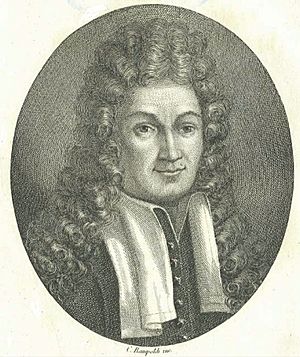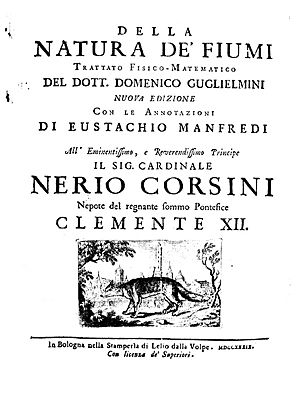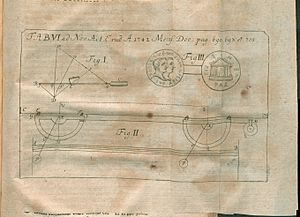Domenico Guglielmini facts for kids
Quick facts for kids
Domenico Guglielmini
|
|
|---|---|

Lithography of Domenico Guglielmini (1821)
|
|
| Born | 27 September 1655 |
| Died | 27 July 1710 (aged 54) |
| Resting place | San Massimo (Padua) |
| Nationality | Italian |
| Alma mater | University of Bologna |
| Spouse(s) | Costanza Gioannetti |
| Parent(s) | Giulio Guglielmini and Gentile Guglielmini (née Neri) |
| Scientific career | |
| Fields | |
| Institutions | |
| Influences | |
Domenico Guglielmini was an important Italian scientist. He was born in Bologna on September 27, 1655, and passed away in Padua on July 27, 1710. He was a talented mathematician, chemist, and physician. He achieved great success in his work, especially in the cities of Bologna and Padua.
Contents
Life of Domenico Guglielmini
Domenico Guglielmini came from a wealthy family in Bologna. He studied medicine at the University of Bologna and graduated in 1678. One of his teachers was the famous scientist Marcello Malpighi. At the same time, he also studied mathematics with Geminiano Montanari. He even became a member of a science group called the Academia della Traccia o dei Filosofi.
Early Studies and Focus on Water
Domenico first wrote about astronomy, which is the study of stars and planets. But soon, he became very interested in hydraulics. This is the science of how water moves and behaves. In 1686, he got a very important job: "Bologna General Water Administrator." This role was crucial because Bologna had many rivers and often experienced floods. His job was to manage these waterways and prevent disasters.
His experiences with managing rivers inspired him to write his most famous book. It was called "Della natura dei fiumi," which means "On the Nature of Rivers." This book is still considered a classic work in the study of how rivers flow.
Family and Academic Career
Domenico Guglielmini married Costanza Gioannetti. They had three daughters and one son, Giuseppe Ferdinando. His son later wrote a biography about his father's life.
In 1690, Domenico became a professor of mathematics at the University of Bologna. Four years later, in 1694, he became a professor of Hydrometry. This field focuses on measuring water flow.
In 1698, a very well-known university, the University of Padua, invited him to teach there. He taught mathematics, astronomy, and medicine. He also helped with a project to fix the defenses of Kotor, a city in Dalmatia (which is now part of Montenegro).
Domenico Guglielmini passed away in 1710 after a long illness. He was buried in the church of St. Massimo in Padua. A grand monument was built in his honor in the Basilica of Saint Anthony of Padua.
Domenico Guglielmini's Scientific Contributions
Domenico Guglielmini made important discoveries in several areas of science. He was especially known for his work on how water moves.
Understanding Water Flow
His most famous work, "Della natura dei fiumi," explained how rivers behave. He used mathematics and physics to describe things like water speed and how rivers shape the land. This book was a big step forward in understanding river systems.
Chemistry and Crystals
Guglielmini also studied chemistry. He was interested in how salts form and their shapes. He wrote about his ideas on the shapes of salts in a book called "Riflessioni filosofiche dedotte dalle figure de' sali" (Philosophical Reflections on the Figures of Salts). He also wrote about salts in another work, "De salibus dissertatio epistolaris."
Medical Insights
As a physician, Domenico Guglielmini also contributed to medicine. He wrote about the nature of blood in "De sanguinis natura & constitutione." He also explored how to correct errors in medical ideas and how to understand diseases better.
Physics and Astronomy
Even though he focused on water, Guglielmini also had an interest in physics and astronomy. He wrote about the nature and origin of comets. He also observed a solar eclipse in 1684 and recorded his findings.



